What treatment is used to repair a broken tooth ?
Sana Oris establishment offers a full range of solutions for treating broken teeth, including options such as dental veneers, crowns and cosmetic repair techniques.
Our expert team is here to support you every step of the way in your recovery, recognising the inconvenience that a damaged tooth can cause. We understand your concerns and are committed to restoring the integrity and function of your tooth, allowing you to return to comfort and smile with confidence.

Composite treatment
A composite treatment is a dental procedure to repair a broken, fractured, chipped or decayed tooth using a plastic resin that imitates the colour of natural teeth. The resin is shaped, hardened by a special light, and the repair is often completed in a single visit.
Composites offer natural aesthetics and preserve healthy tooth structure, requiring less shrinkage than silver fillings. They generally reduce sensitivity to temperature changes, which can reduce tooth sensitivity problems after repair.
However, they may have limits to their strength, especially for teeth subjected to heavy chewing loads. Your dentist will assess the severity of the break and discuss the advantages and disadvantages of the restoration options for your specific case.
Dental crown
A dental crown is a restoration used to repair a severely damaged tooth, offering improved protection, aesthetics and functionality.
The process involves preparing the tooth, taking an impression, placing a temporary crown, fabricating the custom-made crown, final placement and cementation.
Dental crowns offer significant advantages for dental restoration. They provide solid protection against future damage by completely covering the tooth, preventing the spread of cracks or decay. Their durability and resistance to the stresses of chewing ensure a long life. What’s more, crowns are specifically designed to blend harmoniously with natural teeth, resulting in a visible improvement to the smile. Ceramic or porcelain crowns are carefully designed to reflect the shade, shape and appearance of the surrounding teeth, helping to enhance your smile.
They also restore normal chewing function and preserve the natural tooth by preventing excessive enamel shrinkage. Finally, crowns are adaptable to different oral situations, offering an effective solution for restoring teeth in different positions in the mouth.
Fitting a dental crown requires a more invasive preparation of the tooth, involving the removal of part of the enamel. The choice will depend on the severity of the break and discussions with your dentist about a suitable solution.
Dental veneers
A dental veneer is a thin shell of dental material, usually ceramic or composite, that is placed over the visible surface of a tooth to improve its aesthetic appearance. Dental veneers are used to correct a variety of cosmetic problems, such as teeth that are stained, chipped, discoloured, misaligned or have gaps between them. Dental veneers preserve more enamel than other restorations. They offer fast results and resist staining.
The procedure for fitting dental veneers begins with a consultation to assess aesthetic needs and the suitability of veneers. Next, a light preparation of the tooth enamel allows custom-made shells to be placed on the teeth, followed by the taking of precise impressions for fabrication. Temporary veneers can be used to protect the appearance while the permanent veneers are being prepared. Finally, the veneers are fixed with adhesive, with adjustments made if necessary to achieve a perfect fit.
Dental veneers offer many advantages, including significant aesthetic improvement, preservation of tooth enamel, durability with appropriate maintenance, fast procedure, stain resistance, natural customisation, resistance to normal chewing forces, reduced sensitivity compared to metal restorations, and versatility for a variety of dental problems. However, their procedure is generally irreversible, requires slight preparation of the enamel and is not suitable for severe fractures or dental pulp problems. The choice will depend on assessment and discussion with your dentist.
Endodontics
Endodontics focuses on treating the inside of the tooth, in particular the dental pulp. Although it does not directly repair a broken tooth on the surface, endodontics is crucial for preserving and restoring a severely damaged tooth that threatens the pulp. It involves root canal treatment to remove and replace the pulp, possibly followed by stabilisation and external restoration.
Endodontics eliminates dental infections, relieves pain and preserves the natural tooth by treating damaged dental pulp. It restores masticatory function, stabilises the tooth after root canal treatment, and prevents complications such as dental abscesses. It can also relieve tooth sensitivity caused by a break that exposes the pulp.
However, endodontics is not always the optimal solution. For severe breaks, badly damaged pulp, or other complications, alternative treatments such as crowns, dental veneers, or composite fillings may be considered. Your dentist will assess the severity of the situation to advise you on the best approach to repairing your broken tooth.
Why go to Sana Oris ?
Sana Oris is the ideal choice for repairing your broken teeth. Our dental establishment is equipped with state-of-the-art technology and high-quality materials, ensuring long-lasting and aesthetically pleasing results. Our team of dental experts has extensive experience in dental restoration, guaranteeing precise and effective procedures.
Whether you have a chipped, cracked or severely damaged tooth, we offer customised solutions to meet your needs. At Sana Oris, patient satisfaction is our priority, and we are committed to providing you with a revitalised, natural smile thanks to our expertise and state-of-the-art equipment.
